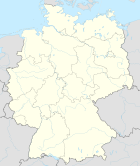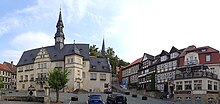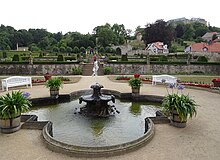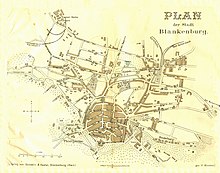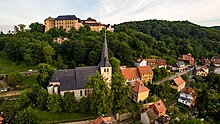Blankenburg (Harz)
| coat of arms | Germany map | |
|---|---|---|

|
Coordinates: 51 ° 48 ' N , 10 ° 58' E |
|
| Basic data | ||
| State : | Saxony-Anhalt | |
| County : | resin | |
| Height : | 288 m above sea level NHN | |
| Area : | 148.89 km 2 | |
| Residents: | 19,703 (Dec. 31, 2019) | |
| Population density : | 132 inhabitants per km 2 | |
| Postcodes : | 06502 (Timmenrode) , 38889 (Blankenburg (Harz), Cattenstedt, Heimburg, Hüttenrode, Wienrode) , 38895 (Derenburg) |
|
| Primaries : | 03944, 03947, 039453 | |
| License plate : | HZ, HBS, QLB, WR | |
| Community key : | 15 0 85 055 | |
| LOCODE : | DE BKG | |
| NUTS : | DEE09 | |
| City structure: | 7 districts | |
| Association administration address: | Harzstrasse 3 38889 Blankenburg (Harz) |
|
| Website : | ||
| Mayor : | Heiko Breithaupt ( CDU ) | |
| Location of the city of Blankenburg (Harz) in the Harz district | ||
Blankenburg (Harz) is a town in the Harz district in Saxony-Anhalt , Germany . It has been a state-approved resort since November 2016 .
geography
The city of Blankenburg (Harz) lies close to the northern edge of the Harz at an altitude of about 234 m. Blankenburg (Harz) is located west of Quedlinburg , south of Halberstadt and east of Wernigerode . The Goldbach flows through the Oesig district to the northwest of the city center.
City structure
The historic old town, laid out around 1200, nestles north of the Blankenstein, on which Blankenburg Castle is located today. This city center can be traced back to the course of the former and still existing city walls. From the 18th century onwards, we can speak of overcoming these narrow limits. During this time the parks and gardens as well as the representative buildings in the baroque style essentially fall. In the 19th century, numerous villas were built in the Classicist, Historicist and Art Nouveau styles, stretching west, north and east of the old town up to higher mountains. The outskirts are characterized by residential and commercial areas of the 20th and 21st centuries.
In addition to this core town, the village districts Börnecke , Cattenstedt , Heimburg , Hüttenrode , Timmenrode , Wienrode and the city of Derenburg belong to Blankenburg (Harz). On July 1, 2014, the new municipal constitutional law of the state of Saxony-Anhalt came into force. In its §14 (2) the municipalities are given the opportunity to assign this designation to the districts that were towns before the incorporation. The city of Blankenburg (Harz) has made use of this regulation. Their amended main statutes came into force on January 13, 2017.
There are also Birkental, Gehren , Helsungen , Michaelstein , Oesig , Pfeifenkrug, Regenstein, Sonnenbreite, Stukenbreite and Westend as unofficial names for districts.
Neighboring communities
| North Harz | Halberstadt | |
| Wernigerode |

|
Quedlinburg |
| Upper Harz on the Brocken | Thale |
history
From the city's foundation to 1599
Finds in the wider area of the city of Blankenburg point to different phases of settlement in the northern Harz foreland from the Neolithic to the Roman Empire . For the period from approx. 400 to 600 AD, the so-called Migration Period , a depopulation of this region can be assumed due to the lack of archaeological traces.
The first documentary mention of Blankenburg Castle goes back to 1123 in a document from Emperor Lothar von Supplinburg . A few years later, he left the facility to his follower Poppo I. von Blankenburg . The descendants of Poppos, who are referred to as Counts of Regenstein-Blankenburg , were subordinate to the nearby Regenstein Castle and Heimburg Castle . The emerging county of Blankenburg existed as a Guelph fief , whereby the fiefdom was occasionally also claimed by the diocese of Halberstadt . In 1180/82 Friedrich Barbarossa had the Blankenburg devastated because the counts of " sole loyalty" had conspired to the Guelph Heinrich the Lion .
The first mention of the city of Blankenburg can be found in a document from the Bishop of Halberstadt from 1212. The city was built around 1200 as a planned system between the eponymous castle and the older settlement Linzke to the north. In the transition from the Middle Ages to the early modern period, this village fell into desolation and was completely absorbed into the city of Blankenburg. The structure of the Blankenburg town hall goes back mainly to the late Middle Ages and the Renaissance period. A hierarchical structure of secular rule (castle / palace), church (St. Bartholomew) and bourgeoisie (town hall) on the mountain slope is characteristic of the cityscape and the medieval structure is still recognizable today through the remains of the city wall and the streets of the old town.
In the middle of the 13th century, the Abbess of Quedlinburg pledged divisional property to Jews from Blankenburg . These apparently lived in Blankenburg and also in Quedlinburg. There is no synagogue in Blankenburg. The oldest parish church in the city of St. Bartholomew was built at the end of the 12th century and is structurally evidence of different phases of use, including a. as a double monastery (secular canon and Cistercian nuns). In the 14th century, the Heimburg line of the Regenstein-Blankenburg counts took over sovereignty over the city and castle after the other Blankenburg lines had died out. Guild rights , i.e. the permission to form craft guilds , were first granted by the Counts of Blankenburg around 1380.
After the death of the last Count of Regenstein, Johann Ernst, the 1599 fell back to the Dukes of Braunschweig-Lüneburg as a "settled fiefdom" .
From devastation to a royal seat
With a number of 255 houses in 1616, Blankenburg can be considered a medium-sized town in the wider region at that time. The city was spared the effects of the Thirty Years' War for a long time, but was finally hard-pressed by Colonel Jean de Merode under Wallenstein's authority and occupied in 1625. Nine cannon balls walled in in the town hall are a reminder of these events. After the war, the city lay largely fallow and impoverished, but the first measures of reconstruction were already supported by Duke Rudolf August, who tried to help Blankenburg .
The dukes of Braunschweig-Lüneburg made the place into a secondary residence in the 17th century, which had its heyday (1690–1731) under Duke Ludwig Rudolf , the second son of Anton Ulrich von Wolfenbüttel. Rudolf received Blankenburg in 1707 as a Paragium . At the same time, the county of Blankenburg was elevated to an imperial principality and ruled independently until 1731, but then reunited with Braunschweig by Ludwig Rudolf. The town also experienced an economic boom through the princely promotion of mining and metallurgy. Many representative buildings and facilities were created under Ludwig Rudolf, the designs of which often came from the master builder Hermann Korb . The vacant lots that arose in the Thirty Years' War were closed, although complete development within the city walls could not be achieved again until the middle of the 19th century.
Duke Ludwig Rudolf ensured a lively cultural life with festivals and theater performances. On November 22nd, 1717, Friederike Caroline Neuber appeared for the first time at Blankenburg Castle . As their patron, Ludwig Rudolph supported the German theater reform together with his wife Christine Luise. Not least through efforts for his Blankenburg estate and the support of the regent, Berend Lehmann had a significant impact on this period, so that, for example, there was even a Hebrew print shop in the city for a short time.
New buildings and renovations under Duke Ludwig Rudolf
|
|
After Ludwig Rudolf's death in 1735, Blankenburg became the widow's residence of his widow Christine Luise von Oettingen-Oettingen until her death in 1747. She decreed that her husband's extensive library should remain at Blankenburg Castle in memory of him. However, this was later transferred to the Collegium Carolinum, opened in 1745 in Braunschweig, and to the Herzog August Library in Wolfenbüttel in 1764 . During the Seven Years' War , the city's complete neutrality gave the Brunswick court under Charles I of Brunswick-Wolfenbüttel a safe refuge. The future French King Louis XVIII also lived in Blankenburg . after his escape from Dillingen under the name "Graf von Lille" from August 24, 1796 to February 10, 1798. From 1731 the principality was permanently connected with Braunschweig-Wolfenbüttel in personal union, but remained an independent imperial estate until 1805.
From 1805 until the end of World War II

From 1807 to 1813 Blankenburg belonged to the Kingdom of Westphalia . After the Congress of Vienna , the Duchy of Braunschweig was formed from the Principality of Braunschweig-Wolfenbüttel . The Braunschweigischen Harz areas and the area of the principality of Blankenburg were combined to form the district of Blankenburg in 1833 . From 1850 the district court Blankenburg existed in the city .
With the establishment of the empire in 1871, there was an economic boom in the Harz city. In 1872 the Harzer Werke for smelting and processing the ores of the Blankenburg area was founded and in 1873 the connection to the rail network by the Halberstadt-Blankenburg Railway . At the same time, tourism increased, so that hotels and pensions were created. Under these positive conditions, the population also increased considerably. On the one hand, German and Polish workers from the east settled down, creating the Catholic Church of St. Joseph in 1882 , and on the other hand, pensioners from the nearby cities chose Blankenburg as their retirement home. In this context, extensive areas with Art Nouveau villas emerged. In 1885, the Rübelandbahn line was also inaugurated.
The naturopath Adolf Just founded the healing earth company Luvos Just GmbH in Blankenburg in 1918 . The construction and commissioning of the Teufelsbad in 1938 and the subsequent recognition as a spa in 1940 are part of this tradition. On the outskirts of the city, this tradition continues with the Teufelsbad specialist clinic, although the status of a spa in favor of a different overall tourist profile has not continued since the 21st century is sought.
At the beginning of the National Socialist era , opponents of the Nazis were persecuted and murdered. In a notorious action by the Braunschweig SS leader Jeckeln in September 1933, 140 communists and social democrats were rounded up in the inn “ to relax ”. Here and in the Blankenburger Hof they were badly mistreated, so that some died as a result. In the wake of the Reichspogromnacht , Jews from Blankenburg were deported to various camps. At the census on May 17, 1939 , twelve Jewish citizens were still registered, including five men.
During the Second World War , Dr. Dasch set up the Blankenburg-Oesig subcamp of the Buchenwald concentration camp and shortly thereafter placed it under the Mittelbau-Dora concentration camp , where around 500 prisoners had to do forced labor in the monastery and the Oda works . There was also a labor camp run by the Gestapo for " half-Jews " who were forced to do hard labor. Another camp was occupied in February 1945 with prisoners from the Auschwitz subcamp Fürstengrube and operated as the subcamp Blankenburg-Regenstein .
The occupation of the city, largely evacuated by German troops , by US troops on April 20, 1945 took place after several days of bomber attacks, artillery and tank bombardment. There was corresponding destruction and casualties among the civilian population.
From the end of the war in 1945 until today
From 1815 to 1945 Blankenburg was the district town of the district of the same name. When Germany was divided into zones of occupation in 1945, the district of Blankenburg was assigned to the British zone after the Potsdam Conference and the London Protocol . Since the larger eastern part of the district was only connected to the rest of the British zone by a road and a narrow-gauge railway , the demarcation was corrected and Blankenburg was assigned to the Soviet occupation zone . The largest part of the district thus later belonged to the GDR and then to the state of Saxony-Anhalt . The main part of the former state of Braunschweig came to the British zone and thus to Lower Saxony . Since 1952 Blankenburg has belonged to the district of Wernigerode . In the post-war period, the city's population grew due to the influx of emigrants and refugees from the eastern German regions .
The tunnels of the Blankenburg-Regenstein facility have been used and expanded by the GDR's National People's Army since 1974 as a large and nuclear-bomb-proof ammunition depot . In 1992 the German Armed Forces moved into the 8 km long tunnel system and built “the largest underground pharmacy in the world” there: for routine tasks of the German Armed Forces, but also for disaster relief all over the world and for military “emergencies”.
From 1987 the Church of St. Bartholomew became a meeting place for political opponents of the political system of the GDR. In 1990, Blankenburg hosted the Braunschweigische Landschaft cultural festival . In the same year Blankenburg again became part of the newly founded state of Saxony-Anhalt. With the establishment of the Berlin Republic , the restructuring of the Blankenburg administration began. The renovation of the historical building stock (old town, gardens and castle), the demographic change as well as the maintenance and strengthening of the infrastructure and economy became core tasks after 1990. On May 25, 2009, the city received the title “ Place of Diversity ” awarded by the German government ".
Blankenburg has been part of the Harz district since 2007. On January 1, 2010, the formerly independent towns of Cattenstedt, Derenburg, Heimburg, Hüttenrode, Timmenrode and Wienrode were incorporated.
For a description of the development of the postal system, see: Postal history of Blankenburg and postal route Braunschweig-Blankenburg .
politics
List of mayors since 1850
|
|
City council
|
City council election 2019
Turnout: 52.27% (2014: 39.91%)
% 30th 20th 10
0
29.97%
11.45%
11.04%
10.1%
7.86%
6.88%
5.59%
4.55%
2.13%
10.42%
Gains and losses
compared to 2014
% p 10 8th 6th 4th 2
0
-2 -4 -6 -8th -10 -9.12 % p
+ 8.26 % p
-2.97 % p
+ 3.1 % p.p.
-3.48 % p.p.
+ 3.43 % p
+1.45 % p
+0.08 % p
+ 2.13 % p
-2.89 % p
|
Since the local elections on May 26, 2019, the city council has been composed as follows:
- CDU : 8 seats (–6)
- LEFT : 3 seats (–2)
- AfD : 3 seats (+2)
- Citizens' initiative Pro Blankenburg: 3 seats (± 0)
- SPD : 2 seats (–2)
- GREEN : 2 seats (+1)
- Derenburg Volunteer Fire Brigade (FFW): 2 seats (+1)
- FDP : 1 seat (+1)
- Union Blankenburg (UB): 1 seat (-1)
- Bürgeraktiv Wienrode (BAW): 1 seat (± 0)
- Cattenstedt community of voters (WGC): 1 seat (± 0)
- Voting community Timmenrode (WGT): 1 seat (± 0)
The AfD won three seats in the election, but only submitted one candidate, so two seats remained vacant.
City partnerships and friendships
- Georgsmarienhütte , Lower Saxony
- Herdecke , North Rhine-Westphalia
- Meerbusch , North Rhine-Westphalia
- Ostrzeszów , Poland (Greater Poland Voivodeship)
- Wolfenbüttel , Lower Saxony
Coat of arms, flag and banner
| Banner, coat of arms and flag | |

|

|

|
|
The current coat of arms was put into effect on July 23, 2016 in the Official Journal and replaced by the previous one; Its blazon is: "In black a grooved and tinned silver round tower with a base and black gate opening, accompanied at the front by a silver shield with a red stag pole and at the back by a silver spade helmet with red stag sticks as a helmet decoration." The two main colors of the coat of arms are silver (white ) and black.
The hoist flag is divided into black and red and centered with the city arms; the banner is split in black and red with the coat of arms in the middle of the cloth.
The previous blazon read: “In black, a silver tower standing on a brick base with a semicircular red gate opening in the middle, crowned by five battlements; on the right accompanied by a shield in silver with a four-ended red stag stick turned to the left, on the left accompanied by a silver pot helmet with two attached, outward-facing red four-ended stag sticks as a crest ornament. "
Next to the tower as a symbol of the mounting stand coat of arms and crest of the counts of Regenstein .
Culture and sights
Buildings and natural monuments
- Baroque castle Blankenburg (Harz) u. a. with a restored and occasionally used theater hall
- Baroque small castle with the accompanying castle gardens , which belong to the Network Garden Dreams Saxony-Anhalt
- Schlosshotel Blankenburg (former palace barracks ) and the Kurhotel Fürstenhof
- Remains of the former Luisenburg pleasure palace
- Geological natural monument Teufelsmauer as a bizarre sandstone formation, which is accessible via hiking trails and shows prehistoric and historical traces of work on the rocks
- Observation tower Wilhelm-Raabe-Warte west of Blankenburg (Harz) on the Eichenberg
- Ziegenkopf observation tower with gastronomy
- Ruin castle and fortress Regenstein . Below the rain stone are the so-called sand caves in the army and not far from there are the remains of the rain stone mill with a ditch system.
- Former Cistercian monastery Michaelstein Monastery today houses the Saxony-Anhalt Music Academy for education and performance practice and maintains a. a. an instrument museum
- Furthermore, the city of Blankenburg (Harz) has a medieval city center with buildings from different eras (including the medieval half-timbered house at Bäuersche Straße 17 , the Renaissance town hall , the Obere Mühle ) and the beautiful villa district adjoining the old town The turn of the 20th century and the partially preserved medieval town fortifications of Blankenburg .
Churches

- The Evangelical Lutheran Luther Church, located in the Georgenhof on Herzogstrasse, was designed in a neo-Gothic style in the 19th century . Originally the church was called Heiliggeistkapelle, today it is named after Martin Luther .
- The Catholic Church of St. Joseph , named after Joseph of Nazareth , is located on Helsunger Straße. It was built in 1882 in the neo-Romanesque style. Her parish of the same name belongs to the dean's office in Halberstadt , and the chapel in Hasselfelde , which has now been profaned , also belonged to it .
- The baroque monastery church belongs to the Michaelstein monastery , a former Cistercian monastery. It was inaugurated in 1720, but has only been used for church services on special occasions since 2000.
- Above the town hall stands the medieval parish church of St. Bartholomew , also known as the mountain church. In the tower and in the choir of the church there are parts of the late Romanesque wall from around 1200. The donor figures in the choir, probably around 1300, belong to the further successors of the Naumburg donor figures . Today the church belongs to the Evangelical Lutheran parish in Blankenburg.
- A New Apostolic Church is located on Westerhäuser Straße, it was reopened in 2007 after a renovation.
Museums
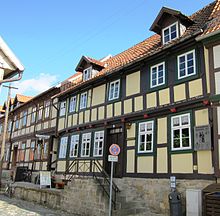
- The hostel museum is unique in Germany . It houses a further collection of materials and a library of handicrafts. In cooperation with the Guild of Righteous Strange Journeyman , the Rolandschacht , the Foreign Freedom Shaft , the Society of Free Vogtlanders of Germany , the Ax and Kelle shaft and the Free Encounter Shaft, there is information about the traditional waltz of the present.
- There is also the Michaelstein Monastery with a herb garden and an instrument museum.
Historical monuments
- Honor grove for concentration camp prisoners and forced laborers of various nationalities at the leveled old cemetery on Lühner-Tor-Platz
- Memorial stone in memory of the concentration camp prisoners of the Blankenburg-Oesig satellite camp near the former Diesterweg school in the Oesig area
- Memorial plaque in Mauerstrasse 14 for the conviction of 63 anti-fascists in September 1933
music

The city's musical life is shaped , among other things, by the Telemann Chamber Orchestra , the rock-pop band Markenzeichen , the gospel choir of the Gymnasium Am Thie and the vocal ensemble Spinnesänger . Nationally successful musicians include the band SUNBEAT, Ska-T and the singer Toni Kater . The Michaelstein Monastery Music Academy can be seen as a supraregional center of musical life.
Movie
Since the 2000s in particular, the city has become a popular film location. Special attention is paid to the Great Castle , Regenstein Castle and the nearby sand caves and the Devil's Wall . Blankenburg is a secondary location for the ARD television series Alles Klara , which is set in Quedlinburg , where the old post office in Blankenburg serves as a police headquarters. Parts of the film Black Death were also shot with Sean Bean in the lead role. The castle and the sand caves served as backdrops for this film. In addition, the film 1½ Knights by Til Schweiger was shot on the Regenstein castle ruins and the surrounding forests. The film adaptation of Tschick , which was also shot on the Regenstein, came to the cinema in 2016.
Regular events
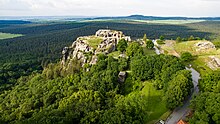
- Blankenburg Carnival (in the Sportforum)
- Viking Festival (Easter)
- Knight tournament (in July)
- Old Town Festival (in August)
- Michaelsteiner Klosterfest (beginning of August)
- Sternthaler Christmas market
- Historic weekends (railways and markets; baroque palace gardens and parks)
- Michaelsteiner monastery concerts (all year round) as part of the music festivals Saxony-Anhalt
- Blankenburg chess tournament (in the town hall)
Economy and Infrastructure
The most important economic factors in Blankenburg (Harz) are tourism as well as health and spa facilities. There are also several smaller medium-sized companies and traders. The largest industrial company in the city is FEW Fahrzeug- und Entwicklungswerk Blankenburg GmbH, which has around 160 employees and dates back to 1873. This is followed by Harzer Werke Motorentechnik GmbH with around 60 employees, which emerged from a gray cast iron foundry founded in 1870. The construction company Umwelttechnik und Wasserbau GmbH is based in Blankenburg. It is the legal successor of the combine operation Speicherbau Ostharz of the VEB Spezialbaukombinat Wasserbau.
traffic
Road traffic
Blankenburg is directly connected to the federal motorway 36 with the two junctions center and east . Furthermore, the B 27 run in a south-west direction and the B 81 in a north-south direction through Blankenburg.
For the development of the postal system in Blankenburg (Harz) see: Braunschweig-Blankenburg postal route .
On the southern edge of the village there are the remains of the so-called ore-level railway on the slope from the time of the industrial revolution .
Rail transport
The Blankenburg (Harz) Station is a railhead and has a bypass curve for freight transport. There are connections to Elbingerode (Rübelandbahn) (freight traffic only) and to Halberstadt . There is a special railway feature in the route of the Rübelandbahn. Due to the steepness of the route, a hairpin was built in at the time. Several times a year there are special steam trips on the tracks of this route. Regional express trains operated by Abellio Rail Mitteldeutschland run every hour to Halberstadt and continue every two hours to Magdeburg. In the 20th century there was still a railway line to Thale and Quedlinburg .
Bus transport
The public transport system is, among other things by the PLUSBUS of the country's network of Saxony-Anhalt provided. The following connections lead through Blankenburg:
- Line 230: Wernigerode ↔ Benzingerode ↔ Blankenburg ↔ Westerhausen ↔ Quedlinburg
- Line 250: Wernigerode ↔ Benzingerode ↔ Blankenburg ↔ Timmenrode ↔ Thale
The Harzer Verkehrsbetriebe as well as the city traffic operate the bus traffic in the Harz district .
Educational institutions
schools
- Primary schools: Am Regenstein primary school, Martin Luther primary school, Derenburg primary school, Timmenrode primary school
- Secondary school: August-Bebel-Schule
- Gymnasium: Gymnasium Am Thie
- Special school: Pestalozzi School Wienrode
Other educational institutions
- State Music Academy, Michaelstein Monastery
- Education and training institute of the state of Saxony-Anhalt
- Überlingen Academy
- District Music School
- Harz District Adult Education Center
- VHS Bildungswerk
- Music school Schicker
Leisure and sports facilities
- Am Thie outdoor pool
- Outdoor swimming pool in Derenburg
- Sports forum
- Sports field "Glück Auf" Hüttenrode
Personalities
literature
- Bernhard Kiekenap : Traces of the lion - history and tradition in Braunschweig and Blankenburg . Appelhans Verlag, Braunschweig 2002, ISBN 3-930292-65-3 .
- Gustav Adolph Leibrock: Chronicle of the city and the principality of Blankenburg . Volume 1, Blankenburg 1864. (full text)
- Johann Georg Leuckfeld : Genealogical and historical description of the counts of Blanckenburg who lived before the Hartz-Walde . Frankfurt / Leipzig 1708. (full text)
- Karl Steinacker : The architectural and art monuments of the Blankenburg district (The architectural and art monuments of the state of Braunschweig, Vol. 6) . Wolfenbüttel 1922.
- Rudolf Steinhoff: History of Graffschaft - resp. of the Principality of Blankenburg, the Graffschaft Regenstein and the Michaelstein Monastery . Blankenburg a. H./Quedlinburg 1891. (full text)
- Johann Christoph Stübner: Oddities of the Harz region in general and the principality of Blankenburg in particular . Volume 1, Halberstadt 1791. (full text)
- Gabriele Voigt: Residence / Lustgarten / Small Castle . Blankenburg 1996.
Web links
Individual evidence
- ↑ State Statistical Office Saxony-Anhalt, population of the municipalities - as of December 31, 2019 (PDF) (update) ( help ).
- ↑ Local constitution law of the state in the version of July 1, 2014
- ↑ See Paul Höfer : The prehistoric settlement of the area around Blankenburg , in: Zeitschrift des Harz-Verein für Geschichte und Altertumskunde 46 (1913), pp. 66-69.
- ↑ Cf. Christoph Georg Rohrbach: Die Wüstung Linzke in the Blankenburg city area , in: Harz-Zeitschrift 69 (2017), pp. 48–65.
- ↑ Cf. Eberhard Brecht, Manfred Kummer: Jews in Quedlinburg. Halberstadt 1996, p. 7.
- ↑ Cf. Karl Steinacker : The problem of the Bartholomäuskirche in Blankenburg a. H. , in: Zeitschrift des Harz-Verein für Geschichte und Altertumskunde 47 (1914), p. 281.
- ↑ Cf. Georg Bode: On the history of the guilds in Blankenburg a / H. , in: Zeitschrift des Harz-Verein für Geschichte und Altertumskunde 19 (1886), pp. 478–481.
- ↑ See H. Müller: About the population and the size of the city of Blankenburg before the beginning of the 30 Years War , in: Journal of the Harz Association for History and Antiquity 39 (1906), pp. 325–329.
- ↑ Cf. Rudolf Steinhoff: History of Graffschaft - respectively. of the Principality of Blankenburg, the Graffschaft Regenstein and the Michaelstein Monastery. Blankenburg a. H./Quedlinburg 1891. p. 152.
- ↑ Cf. Gustav Adolph Leibrock: Chronicle of the City and the Principality of Blankenburg. Volume 2, Blankenburg 1865. p. 131.
- ↑ 1764: Duke Ludwig Ernst (1718–1788) 2345 vols; on hab.de
- ↑ Jürgen Möller: The fight for the Harz. April 1945. Rockstuhl Verlag, Bad Langensalza 2011, ISBN 978-3-86777-257-0 , pp. 284-288.
- ^ Sven Voss in the mdr show Echt , March 9, 2010.
- ^ Database census 2011, Blankenburg (Harz), city, age + gender
- ↑ StBA: Area changes from January 1 to December 31, 2010
- ↑ See: Hartmut Wegner: The mayor list of the city of Blankenburg , in: Brage bei der Wieden, Henning Steinführer (ed.): Office and responsibility. Local authority responsible for self-government in the area of activity in the Braunschweig landscape. Braunschweig: Appelhans Verlag 2015. pp. 76–78.
- ↑ a b Election results final version 2019 - City Council Blankenburg / Harz. (PDF) In: blankenburg.de. May 29, 2019. Retrieved August 28, 2019 .
- ↑ Results of the European and local elections on May 25, 2014 ( Memento from June 5, 2014 in the Internet Archive ) - blankenburg.de
- ^ District of Harz (Hrsg.): Official Journal of the District of Harz . No. 7/2016 . Halberstadt July 23, 2016, p. 10 ( Kreis-hz.de [PDF]). Online edition, PDF ( Memento from August 7, 2016 in the Internet Archive )
